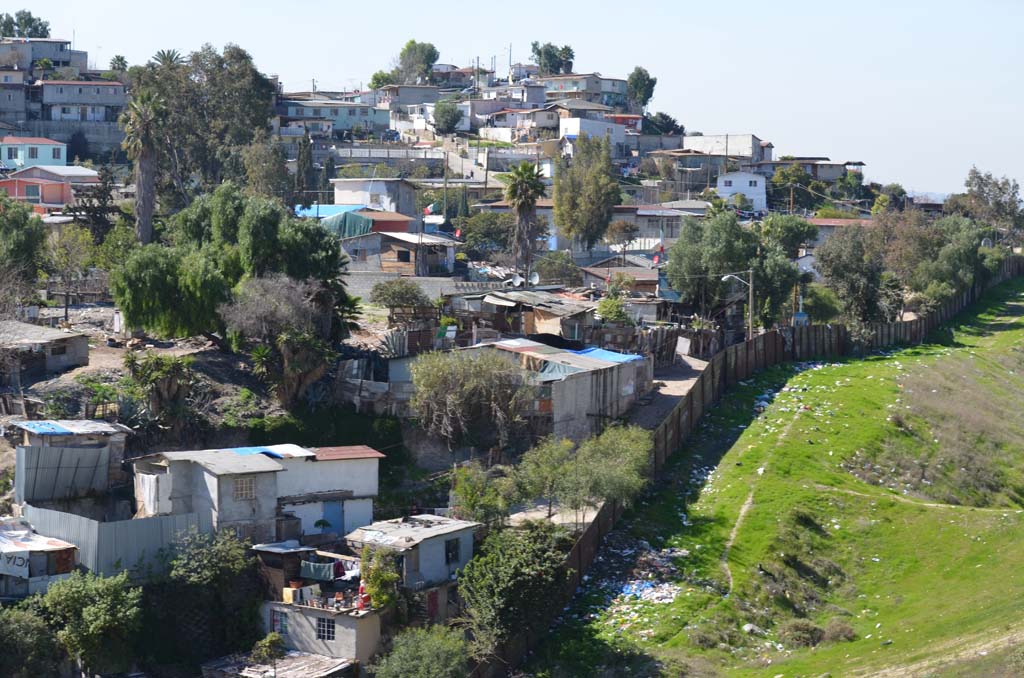COAST CITIES — House upon house fills up a hillside in a portion of the Tijuana neighborhood of Colonia Libertad. It’s a warm, sunny mid-morning. Music plays from a storefront, a woman ushers some children across a quiet street and a dog slinks through a series of tarp covered sheds, intermingled between pink and yellow Spanish Colonial-style homes. Not more than a few feet from the properties’ edges, a fence line as tall as 6-to-8-feet runs to the east and west for as long as the eye can see.
The fence is the international boundary between the U.S. and Mexico.
All of this is visible from a well-maintained, weatherproof road that U.S. Border Patrol agents travel daily. Towers topped with video cameras and stadium-style lighting are spaced at intervals along the road. The cameras, equipped with infrared and night vision capabilities are constantly monitoring the area, and the lights illuminate the space in between Tijuana and the U.S. nightly.
On this road, agents patrolling see a variety of conditions from impoverished and poor communities to some of the nicest beachfront communities around.
“As far as smuggling goes on…maybe someone could speculate, ‘OK, in the impoverished areas, there might be more,’ that’s not the case, actually,” said Border Patrol Agent Jacopo Bruni. “We have not seen a trend where in one neighborhood there’s more traffic because of the fact.”
But based on the ability to conduct interviews with detained smugglers, agents have become well aware that Colonia Libertad is where a lot of smugglers live and base their operations out of, Bruni explained.
“A lot of smugglers actually learned their trades from generations being passed on and on, and it came from here,” he said.

San Diego Sector’s Border Patrol covers 60 terrestrial miles along the U.S./Mexico international boundary. Eastward from the San Ysidro Port of Entry is desert and mountain ranges; to the west is the Pacific Ocean, where the fence line extends 300 feet into the sea, dividing Imperial Beach from Mexico.
Forty-six of those terrestrial miles have that primary fence running along the boundary as it does near Colonia Libertad. The purpose of that shorter fence isn’t meant to stop pedestrian traffic, Bruni said, but to stop vehicle traffic.
There are 13 miles of secondary fencing, 18-feet tall and topped with concertina wire meant to keep pedestrians from illegally entering the U.S.
The wire, Bruni said, makes it more difficult to cross. But people still try to do it, he added. “Does that mean a criminal organization who makes a lot of money doing this smuggling operation stops? No,” he said, pointing to several cuts, or what he calls “compromises” made along the bottom edges of fence line. All of the compromises had been patched with metal plating.
“They’re still going to try to find a way to defeat it,” Bruni said, “but we have made it much more difficult and we’ve seen a huge reduction in assaults and even in smuggling attempts in this area.”
Reductions in apprehensions are also being documented along the San Diego County Ports of Entry.
According to the Border Patrol’s San Diego Sector fiscal year reports, the total number of apprehensions was at its peak in 1986 with 628,370; for the 2012 year-to-date, there were 28,461 apprehensions, its lowest figure since 1968.
But with the apparent drop in terrestrial-based apprehensions, Bruni said they are seeing an increase in the maritime arrests.
Much of that is due to the added technology, people and infrastructure along the Ports of Entry, which is having a “balloon”-like effect on Mexican cartels, essentially squeezing them westward towards the Pacific Ocean, says Keley Hill.
Hill is the director of marine operations for the San Diego Division of Office of Air and Marine, (the only civilian force trained and equipped to specifically combat marine smuggling and one of 19 law enforcement organizations that’s part of ReCoM, Regional Coordinating Mechanism, which provides maritime law enforcement.)
“So like the balloon, it gets squeezed in one place; it starts to bulge in another. And they (smugglers) started to move to the marine arena because it was an alternative to cross on the land side where it was becoming increasingly more difficult.”
Since 2008, when they began to collect data on maritime smuggling operation apprehensions, the Border Patrol saw its highest activity in 2010 with 867 apprehensions. That number dropped by 27 percent in 2011.
Though the statistics show that in FY 2012 that number has increased by 23 percent with 779 apprehensions made.

The cartels are driving these smuggling operations, Hill explained, all for the purpose of money.
“At the end of the day, it’s converting whatever it is into currency for the cartel and for the people that work for them,” Hill said. “It’s whatever the current charge, what they’re currently charging per head, to move an illegal alien or per pound for the contraband.”
Going back to 2007, Hill said the base rate to move an illegal alien on the water was about $900 a head. “And we come to today, where it’s about $6,000 to $7,000 a head. So when you look at these pangas or these recreational commercial boats that get caught smuggling people — 18 to 20 people in a panga at $6,000 to $7,000 a head — that’s a lot of money.”
Last February, two marine smuggling attempts were thwarted when Border Patrol agents captured vessels attempting to land on North County beaches. In Del Mar, a Zodiac-style vessel carrying 11 people was captured, and all on board were apprehended.
A day later, a panga boat was spotted attempting to come ashore in Carlsbad. One of two on board was apprehended and the load of more than $4 million worth of marijuana was seized. The second suspect swam out to sea, where a search and rescue attempt was made but no suspect or body was located.
Prior to that, there have been six deaths recorded in maritime smuggling operations, according to Border Patrol statistics.
But for those vessel operators that are apprehended, most are often just the day laborers. “All in all, this is kind of the first level of the organization that are actually out in the field moving the products,” Hill said.
The organizations are broken down into a hierarchy, starting with what Hill calls the “brokers.”
“Each broker kind of has a crew that works for him and they’ll be broken up into different cells where you’ll have drivers and operators, the guys who actually move the contraband or people,” Hill said. “And you’ll have a load crew, which will receive the contraband or the people on the U.S. side.
“And then you have lookout crews, which are essentially counter surveillance for law enforcement.”
The miles of beaches along San Diego’s coastline have been used as drop off points for whatever the cargo might be. In most cases the cargo is either people or Mexican grown marijuana.
And what the smugglers are looking for first off is good access and being close to a road, which makes offloading whatever the cargo might be quick and easy.
That’s what makes some of North County beaches an accessible spot for drop offs.
“That second choice (for drop offs) would be something that might be harder, but more isolated,” Hill said. “If it’s harder, it takes them more time. So, if it’s a harder place to get to a road net, or to offload the boat, they would want more isolation.”
Many of the smuggling operations take place under the dark of night, with the operators driving such low-tech vessels such as panga boats to try and elude the high-tech efforts of ReCoM and their layered defense approach.
Here’s where low-tech has its advantages, Hill explained. Using radar there has to be a target to “paint,” and, he added, it works best against hard surfaces as metal. “And you look at these pangas, they’re very low-tech; there’s no fittings on them, no handrails; about the only metal you have might be in and around the control station where you have the wheel and the engine itself. Then you add the sea-stake in there, which confuses things, waves (and) things moving up and down, it can be pretty difficult to see this vessel.”
Not only that, but the pangas are cheap, and they work, Hill said.
“You’ll see a panga or its derivative anywhere in any third world country… It’s a basic wooden boat that can be easily launched, in its most basic form, easily launched from any beach,” Hill said.
With most of the drivers not being trained pilots of the vessels they’re in command of, the likelihood of there being an organized sea route isn’t great, either.
Hill can speak to very specific routes that have been used by particular vessels making a smuggling run, but when it comes to their AOR (Area of Responsibility), the entire Pacific Ocean is the route, he said.
“When I go out on patrol in a boat or on an aircraft, outside of any very specific and timely intelligence, the entire AOR has to be considered in play…and that’s tens of thousands of square nautical miles.”
For those apprehended in a maritime event, Bruni said the Border Patrol has decided to formally deport them.
“That means if they re-enter after that, it’s a felony… and they can face prosecution and jail time.”


